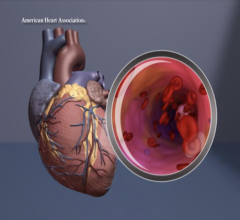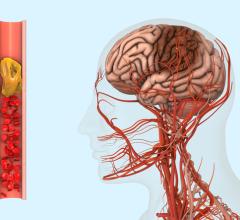
Irregular sleep patterns may play a role in the development of cardiovascular disease, according to a research article published in the Journal of the American Heart Association, JAHA. Photo credit: Getty Images
March 29, 2023 — Irregular sleep patterns may play a role in the pathophysiologic development of cardiovascular disease, according to a research article published in the Journal of the American Heart Association, JAHA.
In “Sleep Irregularity and Subclinical Markers of Cardiovascular Disease: The Multi‐Ethnic Study of Atherosclerosis,” lead author Kelsie M. Full, PhD, MPH, Department of Medicine, Vanderbilt University Medical Center, and co-authors, wrote: Poor sleep, including poor quality, abnormal quantity, and fragmented sleep, is associated with cardiovascular risk factors, incident cardiovascular disease (CVD), and CVD‐related mortality.1, 2, 3, 4, 5, 6 Questions remain about which dimensions of sleep may drive the pathophysiologic development of CVD7 and be promising intervention targets for improving cardiovascular health."1
The researchers examined cross‐sectional associations of actigraphy‐assessed sleep duration and sleep timing regularity with subclinical atherosclerosis in the community‐based MESA (Multi‐Ethnic Study of Atherosclerosis). In this large, racially and ethnically diverse, community‐based cohort, researchers noted sleep duration irregularity (variation in sleep duration >120 minutes in a week) was associated with measures of subclinical atherosclerosis.
Sleep irregularity, particularly sleep duration irregularity, was associated with several measures of subclinical atherosclerosis, according to the researchers in sharing the findings. The authors assessed that sleep regularity may be a modifiable target for reducing atherosclerosis risk, and that future investigation into cardiovascular risk reduction interventions targeting sleep irregularity may be warranted. Encouraging regular sleep schedules may be an important part of clinical lifestyle recommendations for the prevention of cardiovascular disease.
The study is one of the first studies to provide evidence that irregular sleep duration and timing are associated with measures of subclinical atherosclerosis, according to the authors. The development of atherosclerosis is a long process, allowing time for intervention before plaques have formed and hardened and can cause severe stenosis or rupture. Encouraging maintenance of regular sleep schedules with consistent sleep durations may be an important part of lifestyle recommendations provided in clinical practice for the prevention of CVD.
In addition to Full, other researchers of the MESA Sleep Ancillary Study included Tianyi Huang, Neomi A. Shah, Matthew A. Allison, Erin D. Michos, Daniel A. Duprez, Susan Redline and Pamela L. Lutsey. The MESA Sleep Study was supported by National Institutes of Health grant HL56984, and Full was partially supported by National Institute of Health grant HL007779.
Methods and Results
Full et all detailed the methodology, writing: MESA Sleep Ancillary Study participants (N=2032; mean age, 68.6±9.2 years; 37.9% White) completed 7‐day wrist actigraphy. Participants underwent assessments of coronary artery calcium, carotid plaque presence, carotid intima‐media thickness, and the ankle‐brachial index. Sleep regularity was quantified by the 7‐day with‐in person SD of sleep duration and sleep onset timing. Models were adjusted for demographics, cardiovascular disease risk factors, and other objectively assessed sleep characteristics including obstructive sleep apnea, sleep duration, and sleep fragmentation.
Summarizing the results, the authors found that after adjustment, compared with participants with more regular sleep durations (SD ≤60 minutes), participants with greater sleep duration irregularity (SD >120 minutes) were more likely to have high coronary artery calcium burden (>300; prevalence ratio, 1.33 [95% CI, 1.03–1.71]) and abnormal ankle‐brachial index (<0.9; prevalence ratio, 1.75 [95% CI, 1.03–2.95]). Compared with participants with more regular sleep timing (SD ≤30 minutes), participants with irregular sleep timing (SD >90 minutes) were more likely to have high coronary artery calcium burden (prevalence ratio, 1.39 [95% CI, 1.07–1.82]). Associations persisted after adjustment for cardiovascular disease risk factors and average sleep duration, obstructive sleep apnea, and sleep fragmentation.
Insights into Sleep Quality Implications
To explore mechanisms through which poor sleep may lead to CVD development, researchers reported they examined associations of various dimensions of sleep with noninvasive measures of atherosclerosis, which showed to be strongly associated with incident CVD.8, 9, 10, 11, 12 They added that there is a consistent line of cross‐sectional13, 14, 15 and prospective14, 16 evidence to suggest adults with abnormal sleep characteristics are more likely to have significant subclinical atherosclerosis.
An emerging area of interest is whether sleep irregularity, estimated by variation in sleep durations and sleep timing across nights,1, 17 is associated with CVD risk. Irregular sleep patterns and night‐to‐night variations in sleep timing may be indicators of circadian misalignment, or desynchronization of sleep–wake timing, which has been linked to cardiometabolic risk factors.18, 19, 20 Initial studies on regularity of sleep patterns and CVD risk were focused on nurses and shift workers with pronounced variations in sleep schedules.21, 22, 23 However, recent evidence has connected irregular sleep patterns to cardiovascular health in the general population. 20, 24, 25, 26, 27
It remains unknown whether irregularity in sleep durations and timing plays a role in the development of atherosclerosis.27 The MESA (Multi‐Ethnic Study of Atherosclerosis) includes objectively measured sleep data and numerous noninvasive measures of subclinical atherosclerosis, assessed in a diverse sample of older adults. In this study, the researchers specified that they tested the hypotheses that more irregular sleep durations and sleep timing were associated with subclinical atherosclerosis (including prevalent coronary artery calcium [CAC], prevalent carotid plaque, abnormal carotid intima‐media thickness [cIMT], and abnormal ankle‐brachial index [ABI]), after adjustment for cardiovascular risk factors and objectively measured obstructive sleep apnea (OSA), sleep duration, and sleep fragmentation. We were also interested in understanding whether associations were consistent across several subclinical markers.
Sleep Irregularity and CVD Risk Factors
In further analysis of findings, the authors wrote that the in this racially and ethnically diverse sample of older adults, participants with greater sleep duration irregularity were more likely to have a high burden of atherosclerosis as measured across several subclinical markers, specifically higher CAC and an abnormally low ABI. These associations persisted after adjusting for BMI and prevalent CVD risk factors. When the researchers examined sleep timing regularity, they observed an association between greater sleep timing irregularity and high CAC burden, but not with other measures of subclinical CVD. Importantly, the associations observed also persisted after adjustment for severe OSA, average sleep duration, and sleep fragmentation. These results suggest that sleep regularity may have a unique etiologic link to subclinical CVD. Additional insights from the research paper follow.
Sleep regularity may be a modifiable dimension of sleep that can be targeted to reduce CVD risk in aging adults.20 In fact, notes the report, maintaining a regular sleep schedule and decreasing variability in sleep is a key component of clinical sleep hygiene recommendations.46 The authors’ findings suggest that these recommendations — developed to improve sleep — also may be useful as a cardiovascular health promotion strategy. Clinical trials, testing the role of interventions aimed at improving sleep duration regularity as a lifestyle component for CVD risk reduction intervention are warranted.
Almost all major cardiovascular functions, including heart rate, blood pressure, vascular tone, and endothelial functions, are regulated by circadian clock genes.47, 48
Disruption or misalignment of circadian rhythms can interrupt these important cardiovascular functions, resulting in the promotion of chronic inflammation, alterations in glucose metabolism, heightened sympathetic nervous system activation, and increases in arterial pressures, all predisposing to the risk of atherosclerosis progression.22
These hypotheses are further supported by previous studies that have reported increased inflammatory markers, including interleukin‐6 and high‐sensitivity C‐reactive protein, in individuals with irregular sleep patterns49, 50 and increased white blood cell count in individuals with excessive sleep disruption.51 It is also plausible, offered the authors, that irregular sleep patterns may be a marker of irregular health behaviors in general, including irregular timing of meals or exercise, which may contribute to circadian disruption.20, 52
For more information: www.ahajournals/org
https://doi.org/10.1161/JAHA.122.027361
References
1Hall MH, Brindle RC, Buysse DJ. Sleep and cardiovascular disease: emerging opportunities for psychology. Am Psychol. 2018; 73:994–1006. doi: 10.1037/amp0000362CrossrefMedlineGoogle Scholar
2Gottlieb DJ, Yenokyan G, Newman AB, O'Connor GT, Punjabi NM, Quan SF, Redline S, Resnick HE, Tong EK, Diener‐West M, et al. Prospective study of obstructive sleep apnea and incident coronary heart disease and heart failure. Circulation. 2010; 122:352–360. doi: 10.1161/CIRCULATIONAHA.109.901801LinkGoogle Scholar
3Cappuccio FP, Cooper D, D'Elia L, Strazzullo P, Miller MA. Sleep duration predicts cardiovascular outcomes: a systematic review and meta‐analysis of prospective studies. Eur Heart J. 2011; 32:1484–1492. doi: 10.1093/eurheartj/ehr007CrossrefMedlineGoogle Scholar
4St‐Onge M‐P, Grandner MA, Brown D, Conroy MB, Jean‐Louis G, Coons M, Bhatt DL. Sleep duration and quality: impact on lifestyle behaviors and cardiometabolic health: a scientific statement from the American Heart Association. Circulation. 2016; 134:e367–e386. doi: 10.1161/CIR.0000000000000444LinkGoogle Scholar
5Azarbarzin A, Sands SA, Stone KL, Taranto‐Montemurro L, Messineo L, Terrill P, Ancoli‐Israel S, Ensrud K, Purcell S, White DP, et al. The hypoxic burden of sleep apnoea predicts cardiovascular disease‐related mortality: the osteoporotic fractures in men study and the sleep heart health study. Eur Heart J. 2019; 40:1149–1157. doi: 10.1093/eurheartj/ehy624CrossrefMedlineGoogle Scholar
6Hoevenaar‐Blom MP, Spijkerman AMW, Kromhout D, Van Den Berg JF, Verschuren WMM. Sleep duration and sleep quality in relation to 12‐year cardiovascular disease incidence: the MORGEN study. Sleep. 2011; 34:1487–1492. doi: 10.5665/sleep.1382CrossrefMedlineGoogle Scholar
7Aziz M, Ali SS, Das S, Younus A, Malik R, Latif MA, Humayun C, Anugula D, Abbas G, Salami J, et al. Association of subjective and objective sleep duration as well as sleep quality with non‐invasive markers of sub‐clinical cardiovascular disease (CVD): a systematic review. J Atheroscler Thromb. 2017; 24:208–226. doi: 10.5551/jat.36194CrossrefMedlineGoogle Scholar
8Van Der Meer IM, Bots ML, Hofman A, Iglesias Del Sol A, Van Der Kuip DAM, Witteman JCM. Predictive value of noninvasive measures of atherosclerosis for incident myocardial infarction. Circulation. 2004; 109:1089–1094. doi: 10.1161/01.CIR.0000120708.59903.1BLinkGoogle Scholar
9Gupta DK, Skali H, Claggett B, Kasabov R, Cheng S, Shah AM, Loehr LR, Heiss G, Nambi V, Aguilar D, et al. Heart failure risk across the spectrum of ankle‐brachial index: the ARIC study (atherosclerosis risk In communities). JACC Heart Fail. 2014; 2:447–454. doi: 10.1016/j.jchf.2014.05.008CrossrefMedlineGoogle Scholar
10Folsom AR. Coronary artery calcification compared with carotid intima‐media thickness in the prediction of cardiovascular disease incidence: the multi‐ethnic study of atherosclerosis (MESA). Arch Intern Med. 2008; 168:1333–1339. doi: 10.1001/archinte.168.12.1333CrossrefMedlineGoogle Scholar
11Criqui MH, McClelland RL, McDermott MM, Allison MA, Blumenthal RS, Aboyans V, Ix JH, Burke GL, Liu K, Shea S. The ankle‐brachial index and incident cardiovascular events in the MESA (multi‐ethnic study of atherosclerosis). J Am Coll Cardiol. 2010; 56:1506–1512. doi: 10.1016/j.jacc.2010.04.060CrossrefMedlineGoogle Scholar
12Ali SS, Oni ET, Warraich HJ, Blaha MJ, Blumenthal RS, Karim A, Shaharyar S, Jamal O, Fialkow J, Cury R, et al. Systematic review on noninvasive assessment of subclinical cardiovascular disease in obstructive sleep apnea: new kid on the block!Sleep Med Rev. 2014; 18:379–391. doi: 10.1016/j.smrv.2014.01.004CrossrefMedlineGoogle Scholar
13Lutsey PL, McClelland RL, Duprez D, Shea S, Shahar E, Nagayoshi M, Budoff M, Kaufman JD, Redline S. Objectively measured sleep characteristics and prevalence of coronary artery calcification: the multi‐ethnic study of atherosclerosis sleep study. Thorax. 2015; 70:880–887. doi: 10.1136/thoraxjnl-2015-206871CrossrefMedlineGoogle Scholar
14Nagayoshi M, Lutsey PL, Benkeser D, Wassel CL, Folsom AR, Shahar E, Iso H, Allison MA, Criqui MH, Redline S. Association of sleep apnea and sleep duration with peripheral artery disease: the multi‐ethnic study of atherosclerosis (MESA). Atherosclerosis. 2016; 251:467–475. doi: 10.1016/j.atherosclerosis.2016.06.040CrossrefMedlineGoogle Scholar
15Zhao YY, Javaheri S, Wang R, Guo N, Koo BB, Stein JH, Korcarz CE, Redline S. Associations between sleep apnea and subclinical carotid atherosclerosis: the multi‐ethnic study of atherosclerosis. Stroke. 2019; 50:3340–3346. doi: 10.1161/STROKEAHA.118.022184LinkGoogle Scholar
16Kwon Y, Duprez DA, Jacobs DR, Nagayoshi M, McClelland RL, Shahar E, Budoff M, Redline S, Shea S, Carr J, et al. Obstructive sleep apnea and progression of coronary artery calcium: the multi‐ethnic study of atherosclerosis study. J Am Heart Assoc. 2014; 3:e001241. doi: 10.1161/JAHA.114.001241LinkGoogle Scholar
17Buysse DJ. Sleep health: can we define it? Does it matter?Sleep. 2014; 37:9–17. doi: 10.5665/sleep.3298CrossrefMedlineGoogle Scholar
18Leproult R, Holmback U, Van Cauter E. Circadian misalignment augments markers of insulin resistance and inflammation, independently of sleep loss. Diabetes. 2014; 63:1860–1869. doi: 10.2337/db13-1546CrossrefMedlineGoogle Scholar
19Hoopes EK, Witman MA, D'Agata MN, Berube FR, Brewer B, Malone SK, Grandner M, Patterson F. Rest‐activity rhythms in emerging adults: implications for cardiometabolic health. Chronobiol Int. 2021; 38:543–556. doi: 10.1080/07420528.2020.1868490CrossrefMedlineGoogle Scholar
20Zuraikat FM, Makarem N, Redline S, Aggarwal B, Jelic S, St‐Onge MP. Sleep regularity and cardiometabolic heath: is variability in sleep patterns a risk factor for excess adiposity and glycemic dysregulation?Curr Diab Rep. 2020; 20:38. doi: 10.1007/s11892-020-01324-wCrossrefMedlineGoogle Scholar
21Gohari A, Wiebe D, Ayas N. Shift working and cardiovascular health. Chronobiol Int. 2021;1–6. doi: 10.1080/07420528.2021.1933000CrossrefMedlineGoogle Scholar
22Reutrakul S, Knutson KL. Consequences of circadian disruption on cardiometabolic health. Sleep Med Clin. 2015; 10:455–468.CrossrefMedlineGoogle Scholar
23Wang F, Zhang L, Zhang Y, Zhang B, He Y, Xie S, Li M, Miao X, Chan EYY, Tang JL, et al. Meta‐analysis on night shift work and risk of metabolic syndrome. Obes Rev. 2014; 15:709–720. doi: 10.1111/obr.12194CrossrefMedlineGoogle Scholar
24Roenneberg T, Allebrandt KV, Merrow M, Vetter C. Social jetlag and obesity. Curr Biol. 2012; 22:939–943.CrossrefMedlineGoogle Scholar
25Rosique‐Esteban N, Papandreou C, Romaguera D, Warnberg J, Corella D, Martinez‐Gonzalez MA, Diaz‐Lopez A, Estruch R, Vioque J, Aros F, et al. Cross‐sectional associations of objectively‐measured sleep characteristics with obesity and type 2 diabetes in the PREDIMED‐plus trial. Sleep. 2018; 41:zsy190.CrossrefGoogle Scholar
26Huang T, Redline S. Cross‐sectional and prospective associations of actigraphy‐assessed sleep regularity with metabolic abnormalities: the multi‐ethnic study of atherosclerosis. Diabetes Care. 2019; 42:1422–1429. doi: 10.2337/dc19-0596CrossrefMedlineGoogle Scholar
27Chaput JP, Dutil C, Featherstone R, Ross R, Giangregorio L, Saunders TJ, Janssen I, Poitras VJ, Kho ME, Ross‐White A, et al. Sleep timing, sleep consistency, and health in adults: a systematic review. Appl Physiol Nutr Metab. 2020; 45:S232–S247.CrossrefMedlineGoogle Scholar
28Bild DE, Bluemke DA, Burke GL, Detrano R, Diez Roux AV, Folsom AR, Greenland P, Jacobs DR, Kronmal R, Liu K, et al. Multi‐ethnic study of atherosclerosis: objectives and design. Am J Epidemiol. 2002; 156:871–881. doi: 10.1093/aje/kwf113CrossrefMedlineGoogle Scholar
29Oakley NR. Validation with polysomnography of the Sleepwatch sleep/wake scoring algorithm used by the Actiwatch activity monitoring system. Bend, OR: Mini Mitter, Cambridge Neurotechnology; 1997.Google Scholar
30Huang T, Mariani S, Redline S. Sleep irregularity and risk of cardiovascular events: the multi‐ethnic study of atherosclerosis. J Am Coll Cardiol. 2020; 75:991–999. doi: 10.1016/j.jacc.2019.12.054CrossrefMedlineGoogle Scholar
31Patel SR, Weng J, Rueschman M, Dudley KA, Loredo JS, Mossavar‐Rahmani Y, Ramirez M, Ramos AR, Reid K, Seiger AN, et al. Reproducibility of a standardized actigraphy scoring algorithm for sleep in a US Hispanic/Latino population. Sleep. 2015; 38:1497–1503. doi: 10.5665/sleep.4998CrossrefMedlineGoogle Scholar
32Knutson KL, Van Cauter E, Zee P, Liu K, Lauderdale DS. Cross‐sectional associations between measures of sleep and markers of glucose metabolism among subjects with and without diabetes: the coronary artery risk development in Young adults (CARDIA) sleep study. Diabetes Care. 2011; 34:1171–1176. doi: 10.2337/dc10-1962CrossrefMedlineGoogle Scholar
33Redline S, Sanders MH, Lind BK, Quan SF, Iber C, Gottlieb DJ, Bonekat WH, Rapoport DM, Smith PL, Kiley JP. Methods for obtaining and analyzing unattended polysomnography data for a multicenter study. Sleep. 1998; 21:759–767.CrossrefMedlineGoogle Scholar
34Chen X, Wang R, Zee P, Lutsey PL, Javaheri S, Alcantara C, Jackson CL, Williams MA, Redline S. Racial/ethnic differences in sleep disturbances: the multi‐ethnic study of atherosclerosis (MESA). Sleep. 2015; 38:877–888.MedlineGoogle Scholar
35Carr JJ, Nelson JC, Wong ND, McNitt‐Gray M, Arad Y, Jacobs DR, Sidney S, Bild DE, Williams OD, Detrano RC. Calcified coronary artery plaque measurement with cardiac CT in population‐based studies: standardized protocol of multi‐ethnic study of atherosclerosis (MESA) and coronary artery risk development in Young adults (CARDIA) study. Radiology. 2005; 234:35–43. doi: 10.1148/radiol.2341040439CrossrefMedlineGoogle Scholar
36Agatston AS, Janowitz WR, Hildner FJ, Zusmer NR, Viamonte M, Detrano R. Quantification of coronary artery calcium using ultrafast computed tomography. J Am Coll Cardiol. 1990; 15:827–832. doi: 10.1016/0735-1097(90)90282-TCrossrefMedlineGoogle Scholar
37Polak JF, Szklo M, Kronmal RA, Burke GL, Shea S, Zavodni AEH, O'Leary DH. The value of carotid artery plaque and intima‐media thickness for incident cardiovascular disease: the multi‐ethnic study of atherosclerosis. J Am Heart Assoc. 2013; 2:e000087.LinkGoogle Scholar
38Resnick HE, Lindsay RS, McDermott MM, Devereux RB, Jones KL, Fabsitz RR, Howard BV. Relationship of high and low ankle brachial index to all‐cause and cardiovascular disease mortality: the strong heart study. Circulation. 2004; 109:733–739. doi: 10.1161/01.CIR.0000112642.63927.54LinkGoogle Scholar
39Zou G. A modified poisson regression approach to prospective studies with binary data. Am J Epidemiol. 2004; 159:702–706. doi: 10.1093/aje/kwh090CrossrefMedlineGoogle Scholar
40McNutt LA, Wu C, Xue X, Hafner JP. Estimating the relative risk in cohort studies and clinical trials of common outcomes. Am J Epidemiol. 2003; 157:940–943. doi: 10.1093/aje/kwg074CrossrefMedlineGoogle Scholar
41Somers VK, White DP, Amin R, Abraham WT, Costa F, Culebras A, Daniels S, Floras JS, Hunt CE, Olson LJ, et al. Sleep apnea and cardiovascular disease. J Am Coll Cardiol. 2008; 52:686–717. doi: 10.1016/j.jacc.2008.05.002CrossrefMedlineGoogle Scholar
42Roenneberg T, Wirz‐Justice A, Merrow M. Life between clocks: daily temporal patterns of human chronotypes. J Biol Rhythms. 2003; 18:80–90. doi: 10.1177/0748730402239679CrossrefMedlineGoogle Scholar
43Knutson KL, Rathouz PJ, Yan LL, Liu K, Lauderdale DS. Intra‐individual daily and yearly variability in actigraphically recorded sleep measures the CARDIA study. Sleep. 2007; 30:793–796. doi: 10.1093/sleep/30.6.793CrossrefMedlineGoogle Scholar
44Dillon HR, Lichstein KL, Dautovich ND, Taylor DJ, Riedel BW, Bush AJ. Variability in self‐reported normal sleep across the adult age span. J Gerontol B Psychol Sci Soc Sci. 2015; 70:46–56. doi: 10.1093/geronb/gbu035CrossrefMedlineGoogle Scholar
45Edwards BA, O'Driscoll DM, Ali A, Jordan AS, Trinder J, Malhotra A. Aging and sleep: physiology and pathophysiology. Semin Respir Crit Care Med. 2010; 31:618–633. doi: 10.1055/s-0030-1265902CrossrefMedlineGoogle Scholar
46Irish LA, Kline CE, Gunn HE, Buysse DJ, Hall MH. The role of sleep hygiene in promoting public health: a review of empirical evidence. Sleep Med Rev. 2015; 22:23–36. doi: 10.1016/j.smrv.2014.10.001CrossrefMedlineGoogle Scholar
47Skrlec I, Milic J, Steiner R. The impact of the circadian genes CLOCK and ARNTL on myocardial infarction. J Clin Med. 2020; 9:484. doi: 10.3390/jcm9020484CrossrefMedlineGoogle Scholar
48Martino TA, Young ME. Influence of the cardiomyocyte circadian clock on cardiac physiology and pathophysiology. J Biol Rhythms. 2015; 30:183–205. doi: 10.1177/0748730415575246CrossrefMedlineGoogle Scholar
49Kwak HS, Park HO, Kim YO, Son JS, Kim CW, Lee JH, Shin YH, Park SH, Chung EY, Chae CH. The effect of shift work on high sensitivity C‐reactive protein level among female workers. Ann Occup Environ Med. 2019; 31:e5. doi: 10.35371/aoem.2019.31.e5CrossrefMedlineGoogle Scholar
50Okun ML, Reynolds CF, Buysse DJ, Monk TH, Mazumdar S, Begley A, Hall M. Sleep variability, health‐related practices, and inflammatory markers in a community dwelling sample of older adults. Psychosom Med. 2011; 73:142–150. doi: 10.1097/PSY.0b013e3182020d08CrossrefMedlineGoogle Scholar
51Vallat R, Shah VD, Redline S, Attia P, Walker MP. Broken sleep predicts hardened blood vessels. PLoS Biol. 2020; 18:e3000726.CrossrefMedlineGoogle Scholar
52Gabriel BM, Zierath JR. Circadian rhythms and exercise ‐ re‐setting the clock in metabolic disease. Nat Rev Endocrinol. 2019; 15:197–206. doi: 10.1038/s41574-018-0150-xCrossrefMedlineGoogle Scholar
53Carnethon MR, De Chavez PJ, Zee PC, Kim KA, Liu K, Goldberger JJ, Ng J, Knutson KL. Disparities in sleep characteristics by race/ethnicity in a population‐based sample: Chicago area sleep study. Sleep Med. 2016; 18:50–55. doi: 10.1016/j.sleep.2015.07.005CrossrefMedlineGoogle Scholar


 July 24, 2024
July 24, 2024 








